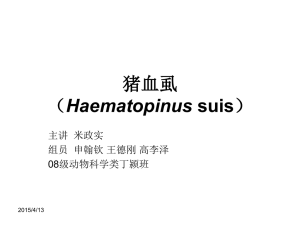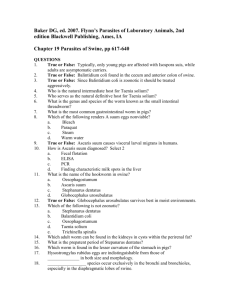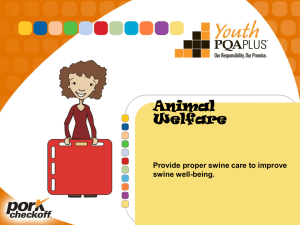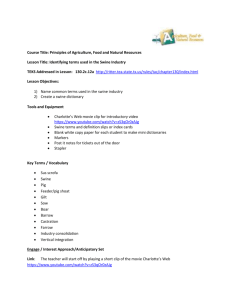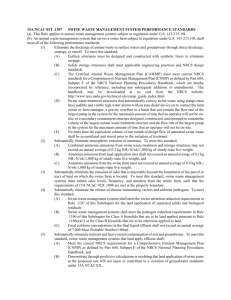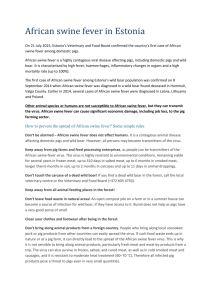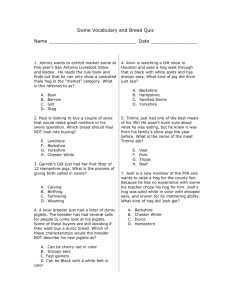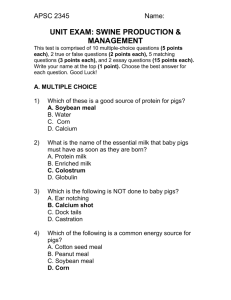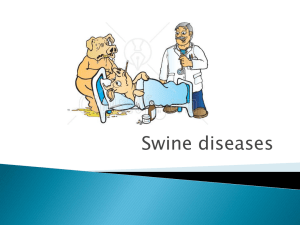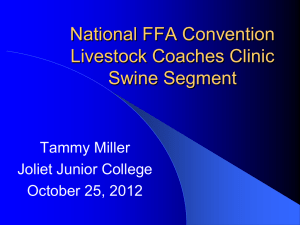swine - Dr. Brahmbhatt`s Class Handouts
advertisement
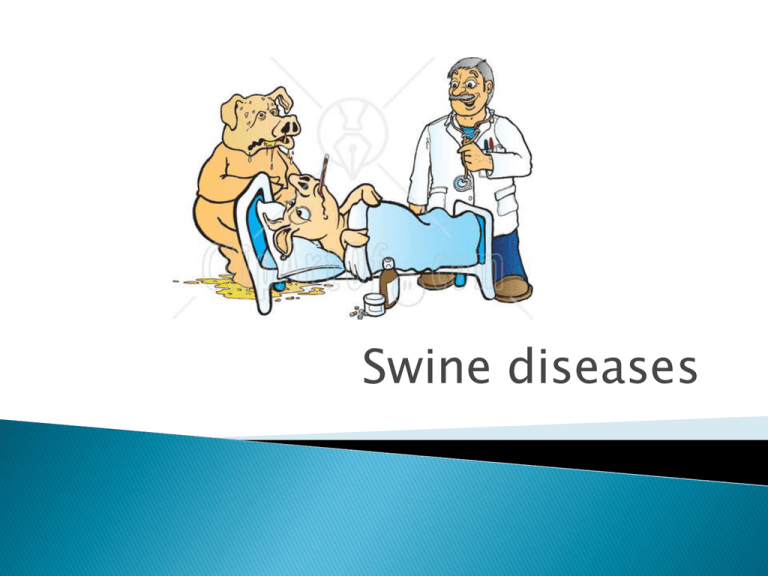
Swine diseases Mange: Sarcoptes scabei var suis Greasy pig disease: Staphylococcus hyicus: Gram-positive coccus Swine pox: Swine pox virus Erysipelas: Erysipelothrix rhusiopathiae: Gram-positive, aerobic, slightly bent, thin bacillus Sarcoptes scabei var suis (not zoonotic) represents the most important ectoparasitic disease of swine nursery or grower pigs Clinical signs intense pruritus, lichenification, papules, crusts poor production susceptible to other diseases Diagnosis - clinical signs, skin scrape Treatment and control, acaricide (amitraz) topically, ivermectin injection ova, larvae, nymphs, adults develop in the epidermis 0.5 mm in length, gray to white, and just visible to the naked eye when on a black background Place the scraping on a piece of black paper for a few minutes. Then carefully blow off the superficial debris and examine the site on the paper for the small, light colored mites. Exudative dermatitis Staphylococcus hyicus: Gram-positive coccus Affects late preweaning pigs: few days to about eight weeks of age Clinical signs exfoliation of skin, excess sebaceous secretion pruritis not a feature unless complicated my mange Diagnosis - clinical signs and culture or histopathology Sebaceous glands secrete excessively and there is accumulation of greasy exudate over lesions Treatment: frustrating Injectible penicllin, oxytetracyline Tetracyclines in feed Topicals: 10% bleach, chlorhexidine, Virkon® (Durvet) or dilute tamed iodine Control Sanitation: sanitation for pregnant sows, especially in housing, and washing of sows may be of value Control external parasites Good nutrition Swine pox virus ◦ Poxviridae family Only pigs less than 4months old “round to oval cutaneous lesions that heal in three to four weeks” Clinical signs papules 1-6 mm in diameter pustules, crusts clear spontaenously Diagnosis - clinical signs, biopsy intracytoplasmic inclusion bodies Treatment - not necessary: herd immunity Erysipelothrix rhusiopathiae ◦ Gram-positive, aerobic, slightly bent, thin bacillus Diamond skin disease: zoonotic pigs 3months - 3years old Clinical signs widespread ecchymotic hemorrhages due to microthrombi arthritis, endocarditis Diagnosis Diamond skin lesions pathognomonic Culture of blood, joints, lung, liver Treatment Penicillin is the drug of choice Control General sanitation Bacterins or attenuated live vaccines Swine lice: louse, Pediculosis Baby piglet anemia Haematopinus suis: zoonotic, 6 mm long (largest louse) Lifecycle ◦ sucking louse (anemia) ◦ entire LC on host Indicator of poor management Clinical signs pruritis (mild), anemia, poor growing Diagnosis visible to naked eye Treatment - same as for mange Iron deficiency Piglets iron demand is greater than the sows milk (15-50%) Pigs raised in the outdoors may not need iron Vit E/ selenium deficiency : Fe toxicity !! Clinical signs anemia within 2-3 days of birth dyspnea, edema, pale skin, lethargy Diagnosis - clinical signs, CBC Treatment - 200mg iron dextran at 1-3 days of age Africa Swine Fever Foot and mouth disease Hog cholera / classical swine fever Swine vesicular disease Malignant catarrhal fever Virus family Flaviviridae, genus Pestivirus Highly contagious viral dz 1978: ‘hog free’ Swine and boars Direct/ uncooked meat CS: High Fever: 106-108oF (>41oC) Depression Conjunctivitis Constipation, then Diarrhea Skin hemorrhages/Cyanosis Stillbirths, deformities, mummies neurologic Renal petechiation African swine fever genus asfivirus in the family Asfarviridae Only DNA virus ~ arbovirus hemorrhage in multiple areas: hot sick red pigs is a tick-borne (ornithodorus), contagious, febrile, systemic viral disease of swine 100% mortality No vaccine 1. Greatly enlarged dark red to black friable spleen 2. Enlarged hemorrhagic gastrohepatic lymph nodes 3. Enlarged hemorrhagic renal lymph nodes ◦ African Swine Fever pigs do not develop conjunctivitis or encephalitis ◦ Despite high fever, ASF infected pigs stay in good condition, whereas hog cholera infected pigs drastically lose weight Foot and mouth disease - apthavirus* Swine vesicular disease - enterovirus Vesicular exanthema - calicivirus Vesicular stomatitis - rhabdovirus http://www.aphis.usda.gov/animal_health/an imal_dis_spec/swine/ http://www.ncsu.edu/project/swine_extensio n/ncporkconf/2002/roberts.htm http://www.vetmed.wisc.edu/pbs/zoonoses/ Erysipelas/erysipelasindex.html http://vetmed.iastate.edu/vdpam/newvdpam-employees/food-supply-veterinarymedicine/swine/swinediseases/haemophilus-parasuishttp://vetpath.wordpress.com/category/necr opsy-cases/ http://www.fmv.utl.pt/atlas/figado/pages_us /figad015_ing.htm http://www.cfsph.iastate.edu/DiseaseInfo/dis ease.php?name=influenza&lang=en http://microgen.ouhsc.edu/a_pleuro/a_pleur o_home.htm http://www.cvm.tamu.edu/fadr/disease.aspx ?did=2500
